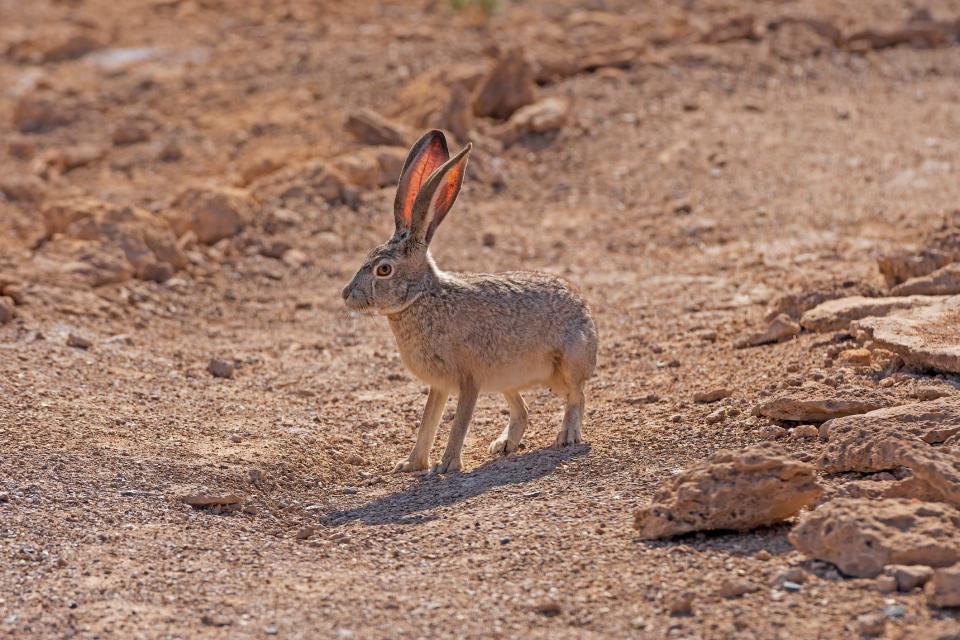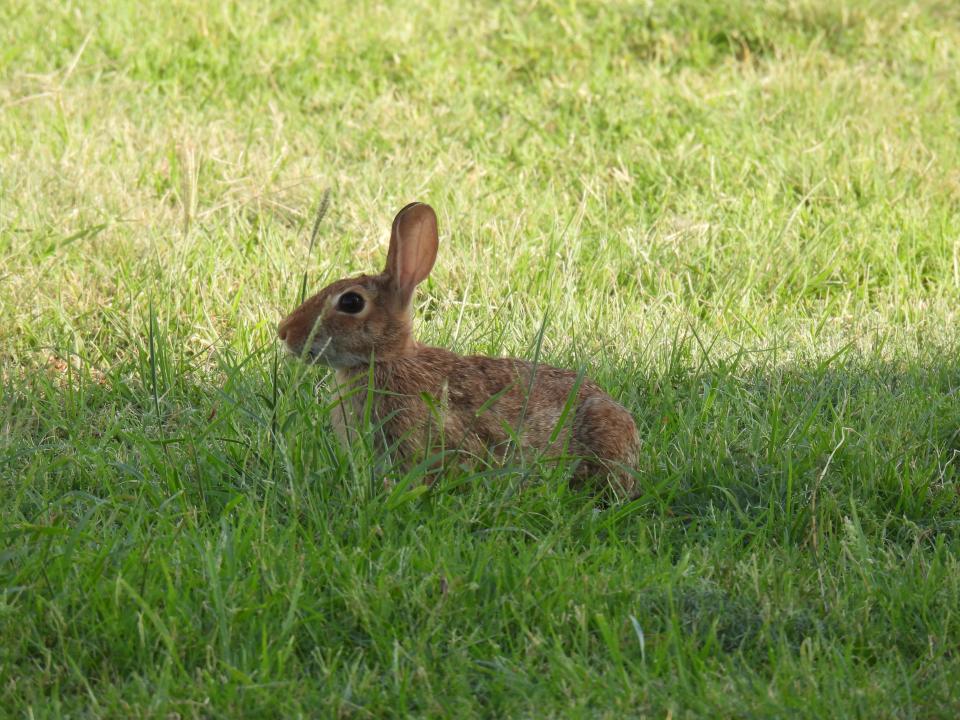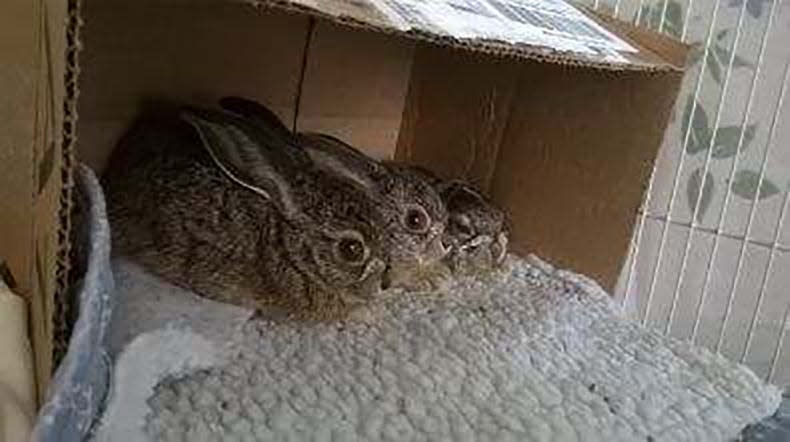Hopping hares and rascally rabbits
Rabbits are common residents of North Texas and Southwestern Oklahoma. They are important prey animals in wildlife communities and can occasionally wreak havoc upon crops, pastures, gardens, and yards. Three species occur in our area: the Eastern and Desert Cottontails and the Black-tailed Jackrabbit. All three are referred to as rabbits; however, the Black-tailed Jackrabbit is actually a hare. “What’s the difference between rabbits, and hares,” you ask?

Rabbits and hares have many common characteristics. Both have long hind limbs and their distinctive ears are long and relatively narrow. They are adapted for hopping and leaping locomotion. Their claws are well-developed and some species (primarily rabbits) are adept diggers. Rabbit and hare teeth are evergrowing to facilitate their gnawing, grazing and browsing diets and all leporids (the familial name of rabbits) have four upper, incisor teeth and two lower incisors. In a feature unique to leporids, the second pair of upper incisors are small, peg-like and positioned directly behind the larger first, upper incisors. The lower incisors’ tips rest between the peg teeth and first upper incisors. This positioning keeps the primary incisors sharpened. Eyes are large and located toward the top and sides of the skull; thus providing excellent eyesight and a wide field of view. Hearing and smell/olfaction of rabbits and hares is excellent and they utilize these keen senses to escape many predators.

Perhaps the most distinctive difference between rabbits and hares are their sizes. Our resident hare, the Black-tailed Jackrabbit, is larger (body length: 24 inches) than either cottontail rabbit species (body length: 16 inches). The Black-tailed Jackrabbit also has longer ears (6 - 7 inches) than the Eastern and Desert Cottontails ( 2.5 and 4 inches, respectively). In fact, an early, common name of the Black-tailed Jackrabbit was the “Jackass Rabbit”: a reference to its long, mule-like ears. As its recent name implies, the upper part of the tail and a narrow band of hair extending onto the hips are black and its ears are also black-tipped. Most of the upper body is grayish-brown and sprinkled with black hairs and its belly is grayish-white.
It is a challenge to distinguish between Eastern and Western Cottontail rabbits where they co-occur in our region. The Desert Cottontail is generally smaller, grayish-brown in color, and has slightly longer ears than the Eastern Cottontail. The Eastern Cottontail is usually a darker, reddish-brown or rusty orange color. Both cottontails have white bellies and the undersides of their tails are snow white; hence, the common name of cottontail as the tail is raised as a white alarm banner whenever the rabbits are startled into flight.

Black-tailed Jackrabbits and Eastern Cottontails are widespread leporids throughout our area; whereas the Desert Cottontail is more common in western counties. Although all three species occur in varying habitats, jackrabbits and Desert Cottontails seem to prefer open areas with sparse or low-growing vegetation; whereas Eastern Cottontails are at home in denser vegetation, brushlands, woods, and riparian areas. The Black-tailed Jackrabbit scratches out a shallow depression (called a form) and rests in the open; whereas, cottontails rest in shallow burrows, ditches, culverts, brushpiles, underneath structures, and within vegetation.
All their diets include various grasses, forbs, herbs, bark, mesquite beans, prickly pear cactus and fruits, and (often to our extreme annoyance) many cultivated and ornamental plants. Foraging occurs during crepuscular and nighttime hours; however, cottontails may also forage during the daytime: particularly during morning hours. Foraging is conducted by cautiously stretching out the head and neck and clipping off plants with the incisors. When fully extended, rabbits draw their hindlegs slowly forward with as little hopping motion as possible. Rabbits are coprophagic and produce two types of fecal pellets: green and grayish-black. The green pellets are composed of undigested plant matter and are reconsumed for one more trip through the digestive system to extract additional nutrients.
When resting, or if alarmed or startled, leporids will remain very still or “freeze” in place, ears lowered, until forced to move or flee from danger. If forced to run/hop away, Black-tailed Jackrabbits can reach speeds of 40 mph and rely on speed to escape their predators; whereas cottontails flush with a zig-zag running pattern at up to 15 – 20 mph and seek refuge in a nearby burrow or other safe retreat. All three leporids have numerous predators: including hawks, owls, snakes, foxes, coyotes, dogs, bobcats, house cats, weasils, mink, raccons, badgers, and skunks.
Rabbits and hares mature rapidly and usually produce several litters per year. Black-tailed Jackrabbit litters range from one to six young (called leverets); whereas, Desert and Eastern Cottontail litters average three to four young (called bunnies) per litter, respectively. Another difference between hares (Black-tailed Jackrabbit) and rabbits (Cottontails) is the development of the young at birth. Jackrabbit leverets are born fully-furred and are able to feed and follow their parent shortly after birth; whereas, Cottontail bunies are born naked, blind, and helpless in a shallow, grass and fur-lined nest/burrow. Cottontail mothers lie over the small nest entrance while their tiny youngsters are nursing.
Several strategies can be used to prevent rabbits and hares from consuming desirable plants in our yards and gardens. The odors of onion, garlic, marigolds, and mint plants naturally deter rabbits. Several types of commercial- products are also formulated to repel rabbits, rodents, and deer. Rabbits avoid or are startled by noise and motion; therefore, windchimes, motion activated sprinklers, or other scarecrow-like objects may help exclude rabbits from some areas. Personally, I have found the most effective defence against hungry rabbits in my vegetable garden is a perimeter fence of chicken wire or small mesh wire with a base of partially buried fence posts.
Although we may take our local rabbits (and hare) for granted, I’m often amazed at their capacities for survival. Perhaps an appropriate way to end this discussion is with a quotation from the novel “Watership Down” by Richard Adams. “All the world will be your enemy, Prince with a Thousand Enemies. And whenever they catch you, they will kill you. But first they must catch you, digger, listener, runner. Prince with the Swift Warning…”
This article originally appeared on Wichita Falls Times Record News: Hopping hares and rascally rabbits

